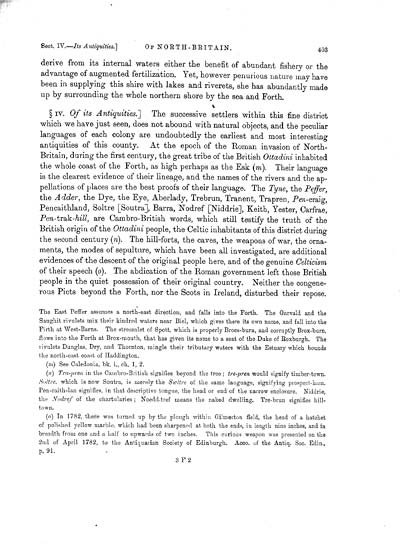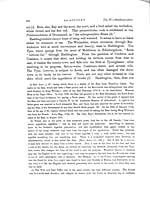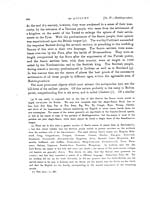Volume 3
(416) Page 403
Download files
Individual page:
Thumbnail gallery: Grid view | List view

403 derive from its internal waters either the benefit of abundant fishery or the advantage of augmented fertilization. Yet, however penurious nature may have been in supplying this shire with lakes and riverets, she has abundantly made up by surrounding the whole northern shore by the sea and Forth. � IV. Of its Antiquities.] The successive settlers within this fine district which we have just seen, does not abound with natural objects, and the peculiar languages of each colony are undoubtedly the earliest and most interesting antiquities of this county. At the epoch of the Roman invasion of North- Britain, during the first century, the great tribe of the British Ottadini inhabited the whole coast of the Forth, as high perhaps as the Esk (m). Their language is the clearest evidence of their lineage, and the names of the rivers and the ap- pellations of places are the best proofs of their language. The Tyne, the Peffer, the Adder, the Dye, the Eye, Aberlady, Trebrun, Tranent, Trapren, Pew-craig, Pencaithland, Soltre [Soutra], Barra, Nodref [Niddrie], Keith, Yester, Carfrae, Pen-trak-hill, are Cambro-British words, which still testify the truth of the British origin of the Ottadini people, the Celtic inhabitants of this district during the second century (n). The hill-forts, the caves, the weapons of war, the orna- ments, the modes of sepulture, which have been all investigated, are additional evidences of the descent of the original people here, and of the genuine Celticism of their speech (o). The abdication of the Roman government left those British people in the quiet possession of their original country. Neither the congene- rous Picts beyond the Forth, nor the Scots in Ireland, disturbed their repose. The East Peffer assumes a north-east direction, and falls into the Forth. The Garvald and the Saughit rivulets mix their kindred waters near Biel, which gives them its own name, and fall into the Firth at West-Barns. The streamlet of Spott, which is properly Brocs-burn, and corruptly Brox-burn, flows into the Forth at Brox-mouth, that has given its name to a seat of the Duke of Roxburgh. The rivulets Dunglas, Dry, and Thornton, mingle their tributary waters with the Estuary which bounds the north-east coast of Haddington. (m) See Caledonia, bk. i., ch. 1, 2. (n) Tra-pren in the Cambro-British signifies beyond the tree ; tre-pren would signify timber-town. Soltre, which is now Soutra, is merely the Swltre of the same language, signifying prospect-ham. Pen-caith-lan signifies, in that descriptive tongue, the head or end of the narrow enclosure. Niddrie, the Nodref of the chartularies ; Noedd-tref means the naked dwelling. Tre-brun signifies hill- town. (o) In 1782, there was turned up by the plough within Gilmerton field, the head of a hatchet of polished yellow marble, which had been sharpened at both the ends, in length nine inches, and in breadth from one and a half to upwards of two inches. This curious weapon was presented on the 2nd of April 1782, to the Antiquarian Society of Edinburgh. Acco. of the Antiq. Soc. Edin., p. 91. 3F2
Set display mode to:
![]() Universal Viewer |
Universal Viewer | ![]() Mirador |
Large image | Transcription
Mirador |
Large image | Transcription
Images and transcriptions on this page, including medium image downloads, may be used under the Creative Commons Attribution 4.0 International Licence unless otherwise stated. ![]()
| Caledonia, or, An account, historical and topographic of North Britain from the most ancient to the present times > Volume 3 > (416) Page 403 |
|---|
| Permanent URL | https://digital.nls.uk/74528906 |
|---|---|
| Description | Of its antiquities |
| Description | Vol. III. |
|---|---|
| Attribution and copyright: |
|

